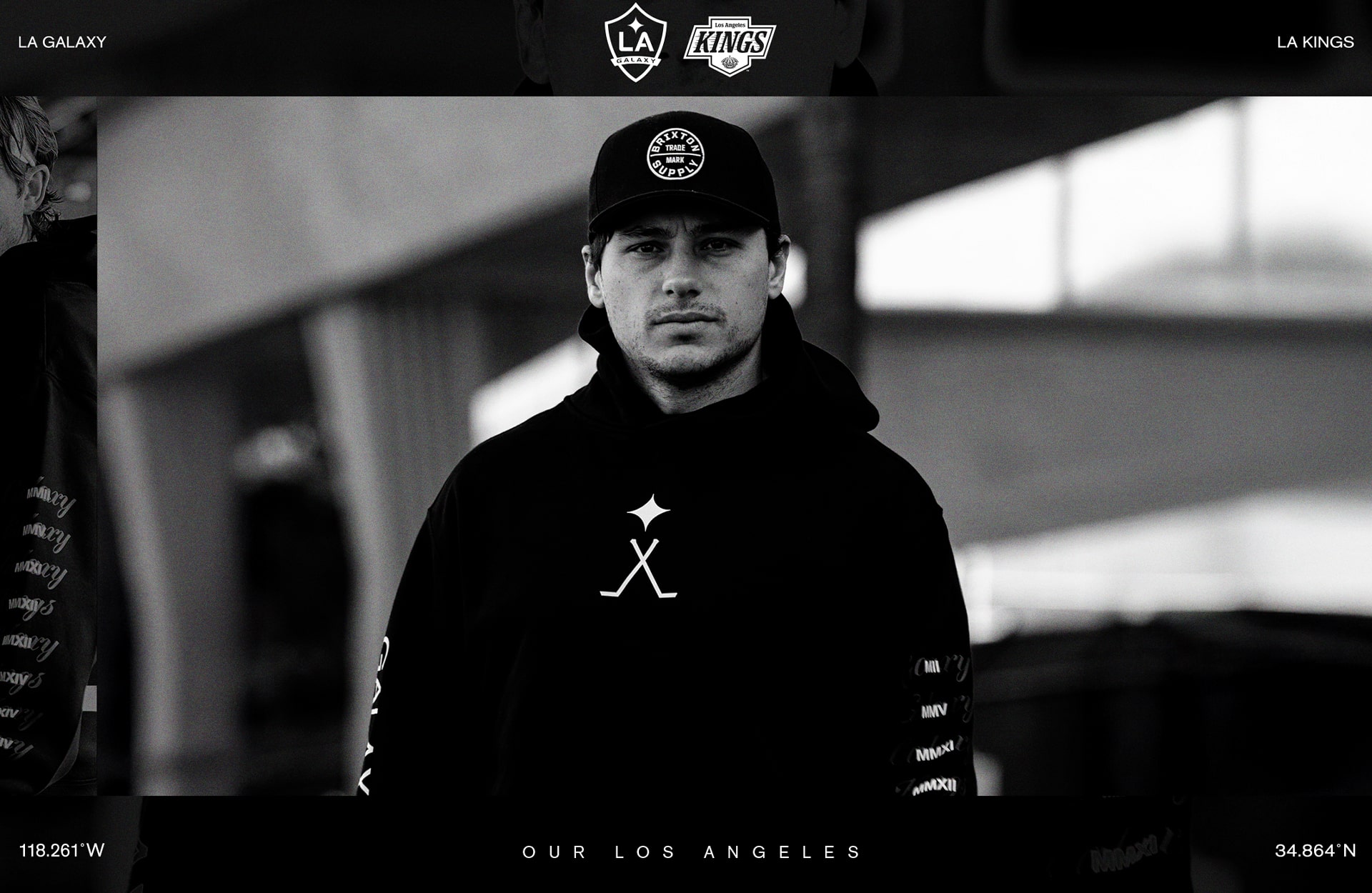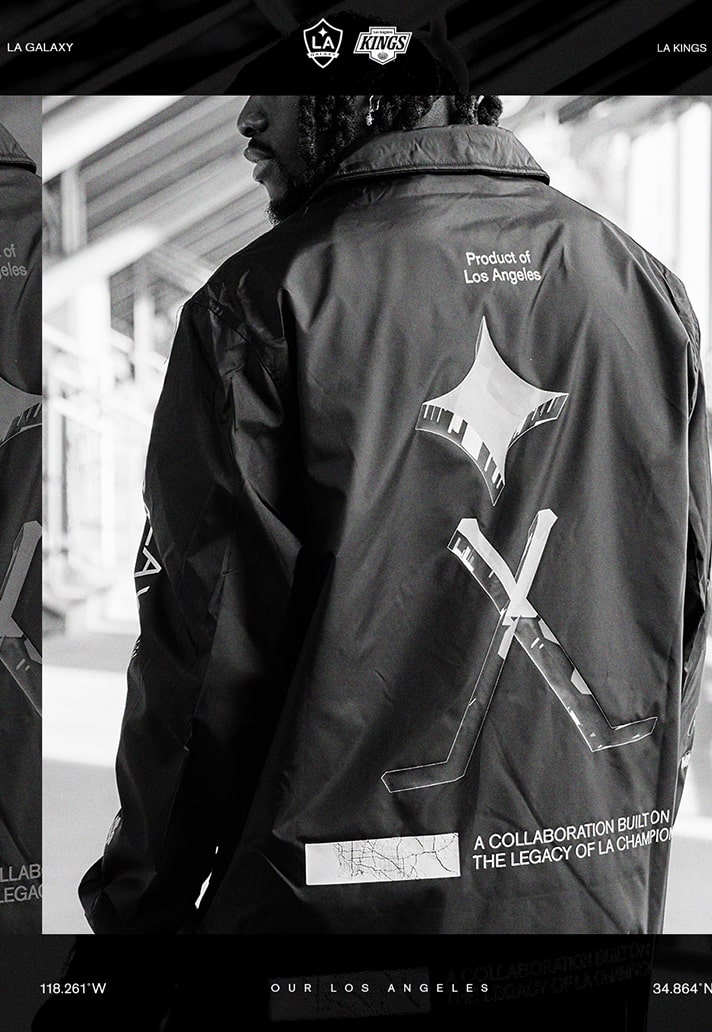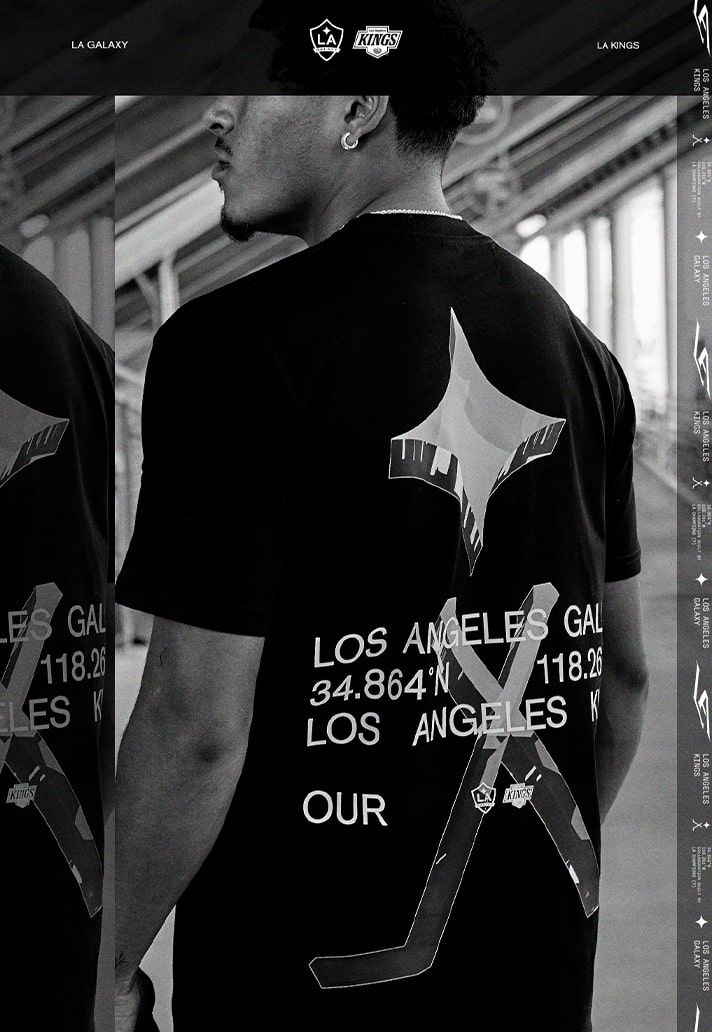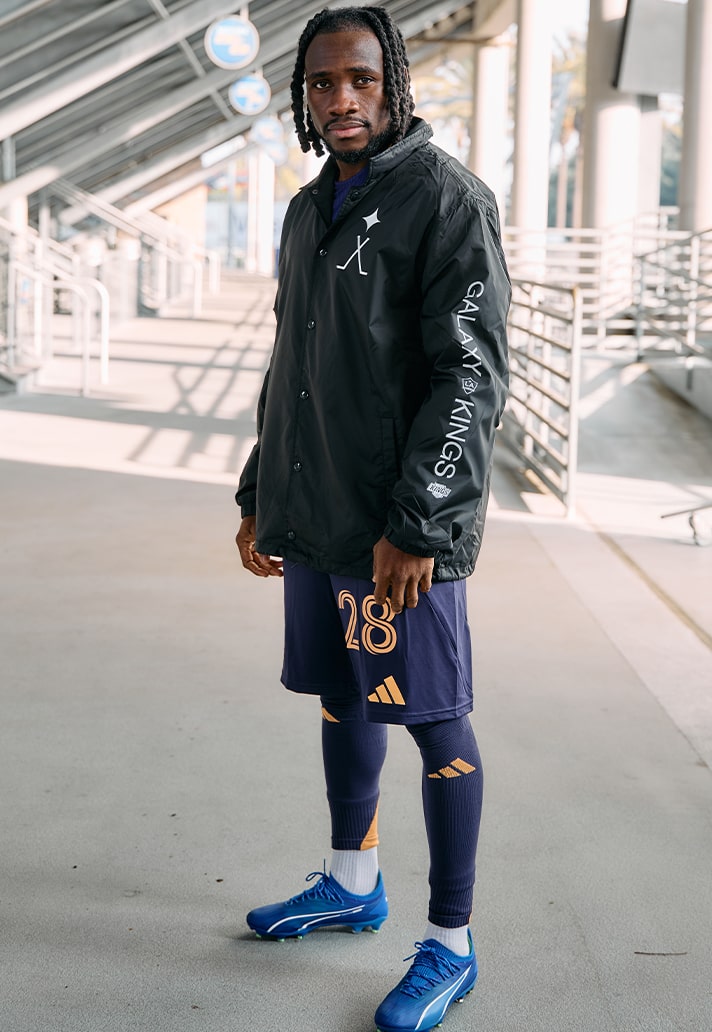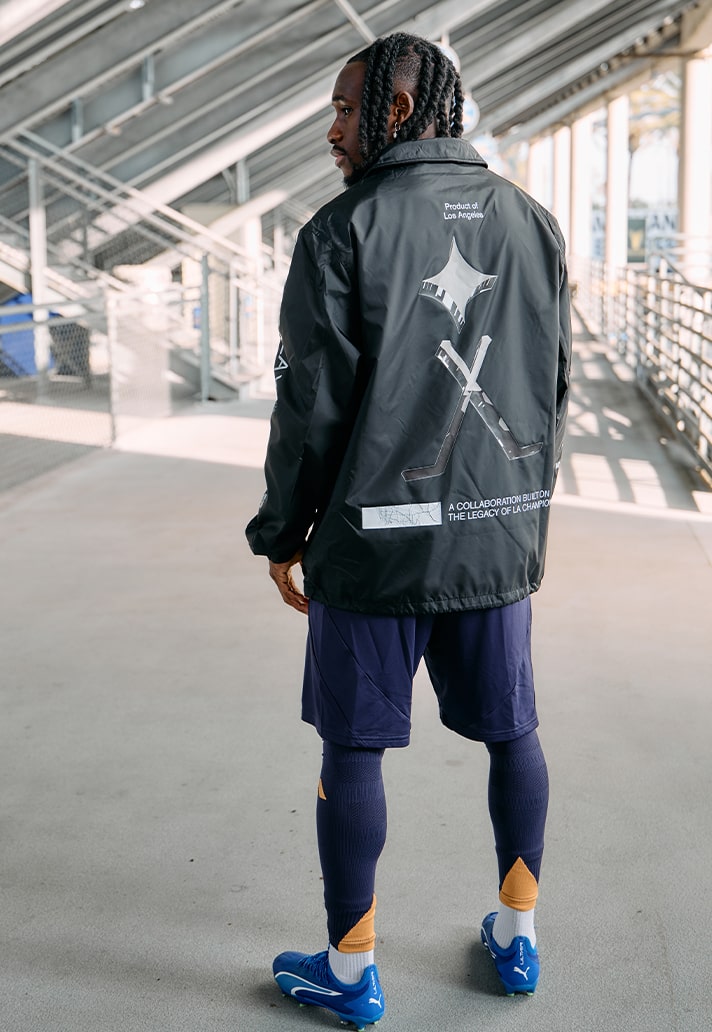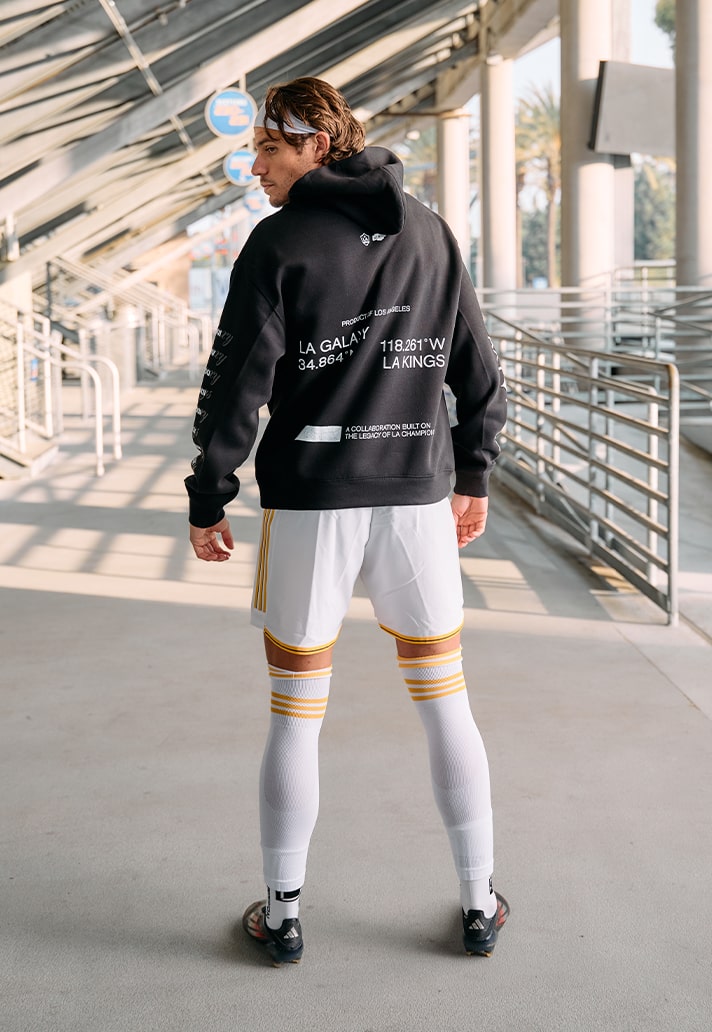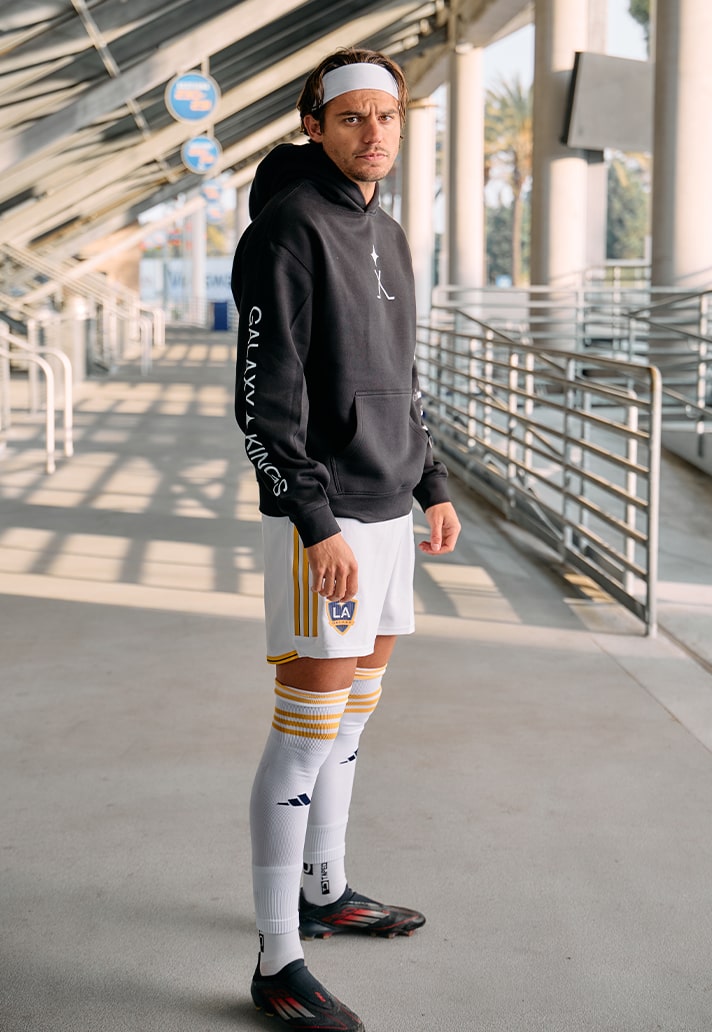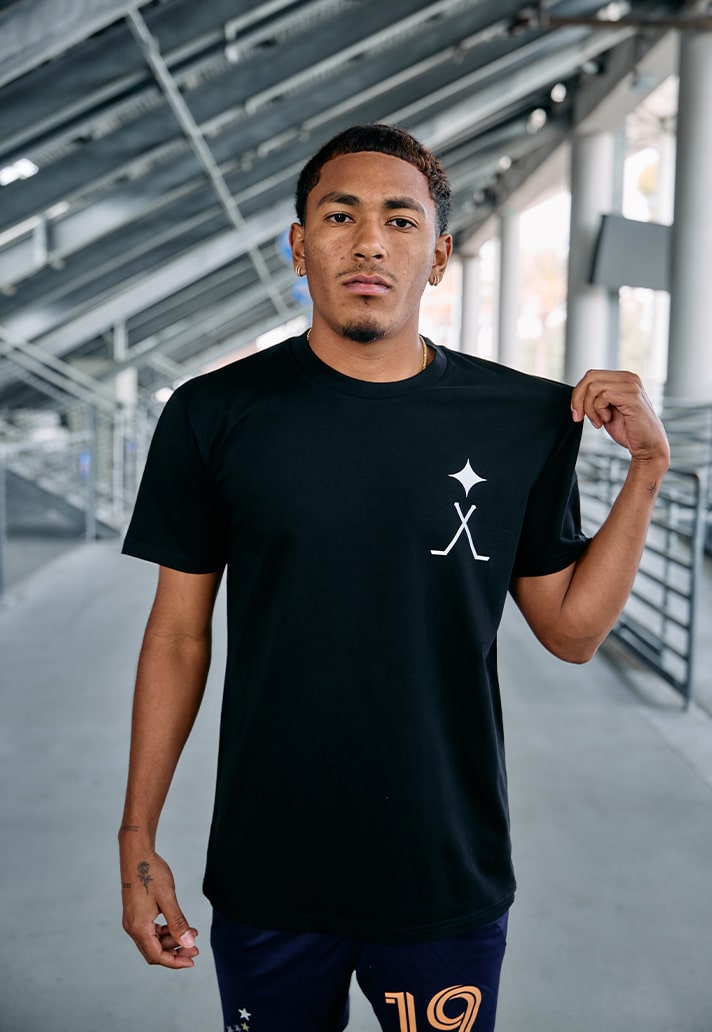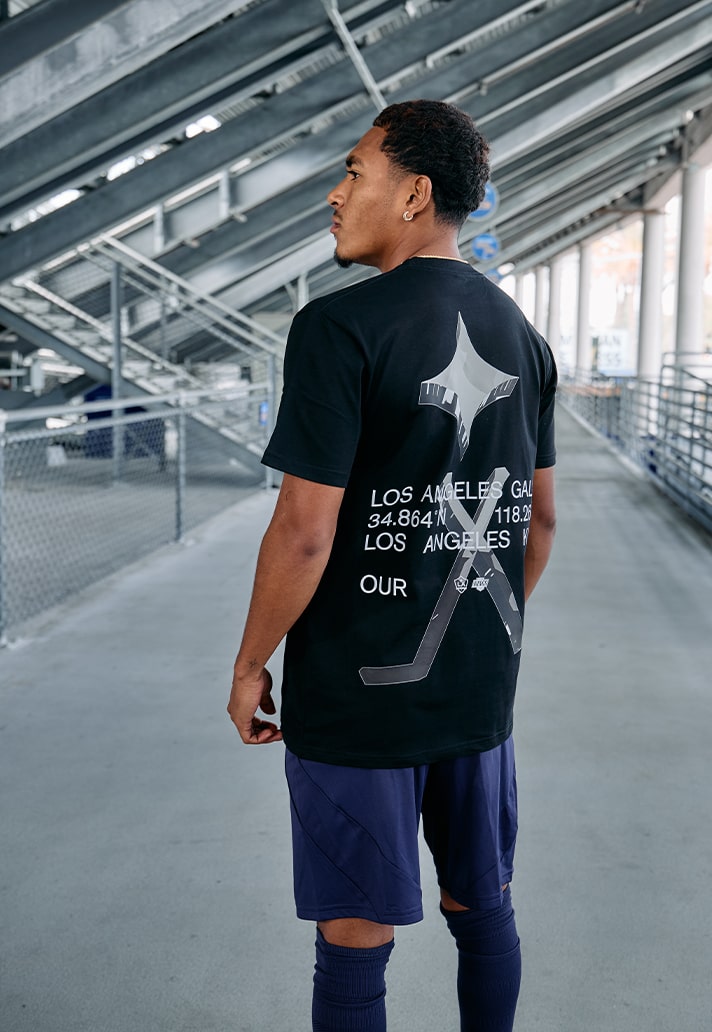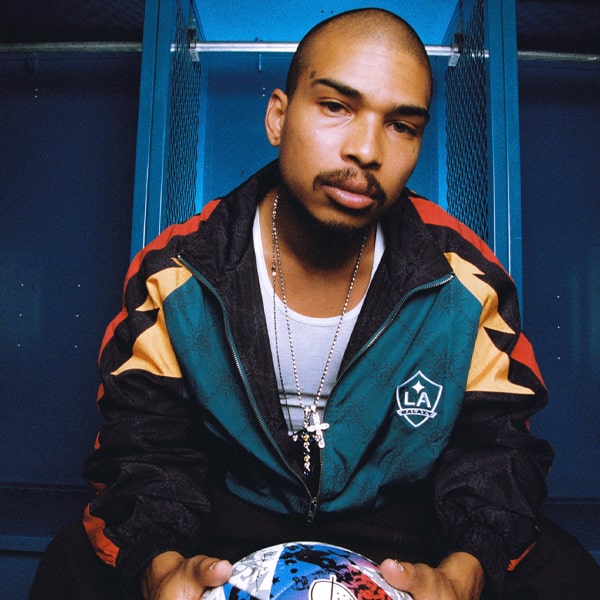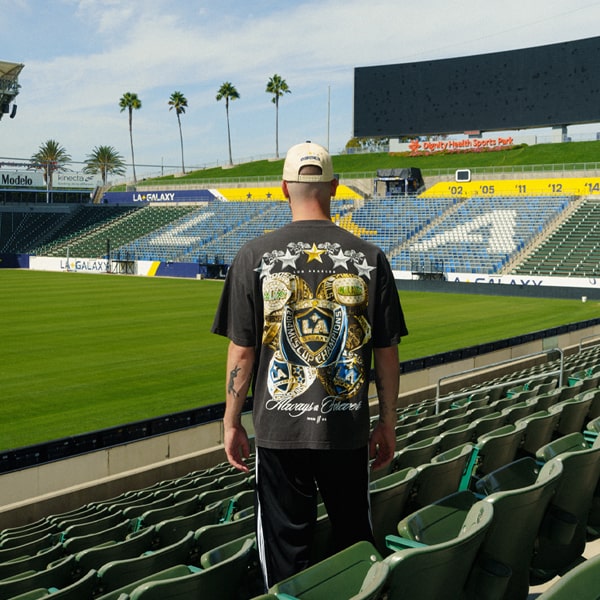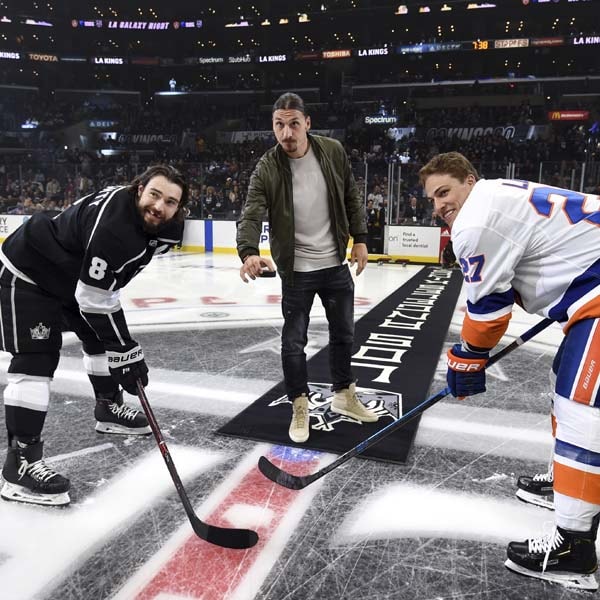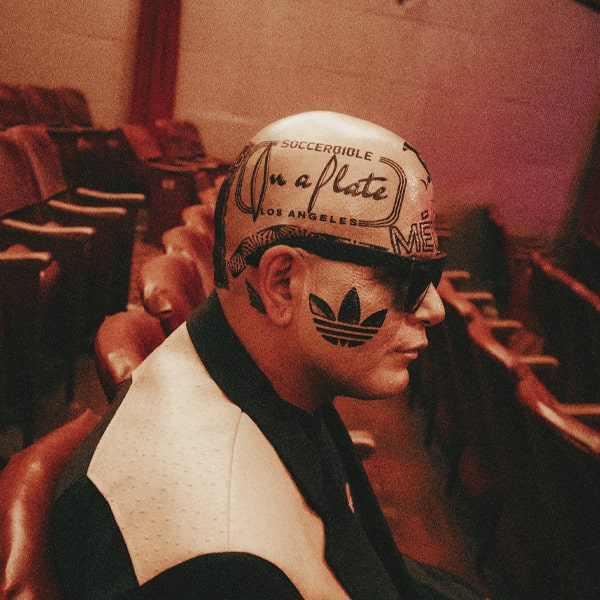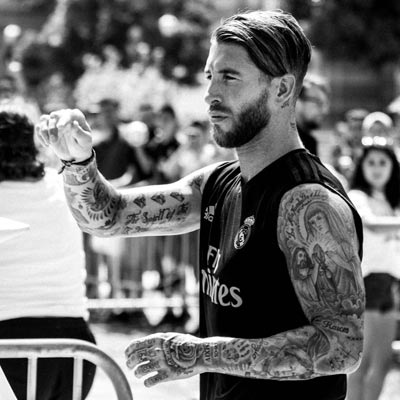Both rooted in the heart of Los Angeles, the LA Galaxy and LA Kings have teamed up for a ground-breaking collaboration, uniting the city’s defining subcultures through fashion and design. The partnership is set to blend both teams’ design elements into innovative lifestyle and fashion pieces, elevating themselves into cultural relevance.
Soccer and Hockey do not share a lot of common traits, however, here to bridge the gap between the two sports are the LA Galaxy and LA Kings. Both teams embedded into Los Angeles DNA have teamed up to bring an unconventional partnership to the table, with intentions to unite the city. Blending Galaxy flair with Kings hustle, both clubs enter their names into fashion and cultural relevance with bold lifestyle designs that resonate with both sets of fans, as well as fashion enthusiasts.
Using visual design elements from both club's, the spotlighted logo featured on all the pieces of the collection arrives as a fusion of the Galaxy Quasar and Kings hockey stick. The quasar symbolises ambition and passion, whilst the hockey stick embodies strength and legacy – displaying the values both clubs look to bring with the collaboration. The capsule is made up of a range of casual lifestyle pieces including a hoodie, jacket and t-shirt – crafted for those that live and breathe LA.
On hearing about the collaboration, we sat down with Will Misselbrook, LA Galaxy’s Chief Brand and Creative Officer, to explore what this means for both clubs and Los Angeles…
This partnership has been in the works for nearly two years—can you walk us through the initial idea?
Being part of the AEG family, the LA Galaxy and LA Kings have always shared a natural connection—two original LA franchises with deep roots and strong identities. So, the idea of collaborating wasn’t anything new. It began with a casual conversation of “We should do something together—something beyond matchday content or the usual cross-promotional moments”. From there, we started exploring what a more meaningful link between the two clubs could look like—and fashion felt like the right direction. A physical product with real design intent, rooted in both brands but designed to go beyond them. We quickly developed a broader creative strategy. This wasn’t about simply putting two logos side by side. It was about creating a shared mark—something abstract, expressive, and reflective of LA’s cultural fabric. A symbol that could live in fashion, content, and streetwear—regardless of whether you followed either team. At LA Galaxy, we’ve been intentional about evolving the brand beyond football—into music, fashion, and storytelling that reflect the creative energy of the city. I’ve always felt that sports brands need to think beyond the traditional playbook. It’s the brand—not the team logo or the result on the pitch—that builds real connection. This kind of cross-sport fashion collaboration helps both clubs rethink how and where our brands exist. And it aligns with where the industry is heading—nearly 70% of Gen Z fans say they follow teams as much for lifestyle and cultural relevance as for sport itself. You see it with PSG, Real Madrid, and collaborations with the likes of Patta and Aimé Leon Dore. The demand is real. This collaboration is a step in that direction—where sports brands don’t just reflect culture but play an active role in shaping it.
From a creative standpoint, what were the biggest challenges in blending two very distinct brands?
The biggest challenge was blending two strong, distinct brands in a way that felt intentional—not like a novelty or a one-off. That meant having a clear creative strategy, aligning across AEG, and getting sharp on the “why” before diving into the “what.” At the time, the LA Kings were going through a brand evolution, so we had to stay closely in sync with where they were headed visually. We broke down both identities—logos, assets, visual cues—and worked toward a shared design system that felt forward-looking but still authentic to both sides. Beyond the mark itself, cohesion came through in the details—merged coordinates on the hoodie, a shared championship nod on the jacket, and a back hit that read “a collaboration built on the legacy of champions.” These were subtle touches, but they mattered. They gave both brands space to live in the same visual world without compromising either one. And we treated the rollout as seriously as the product. This wasn’t a quick drop—it was a full campaign. Players from both teams were involved, visuals were tightly considered, and the storytelling had to match the ambition behind the work. The design made it relevant. The execution made it resonate.
How did you approach aligning the creative teams from both organizations?
The first step was making sure both teams were genuinely excited about the creative vision—which meant spending time on the designs and presentations. Every part of the process was collaborative. It was never about one side directing the other—it was about building something together. We held weekly working sessions to review designs, share feedback, and shape the direction in real time. I think that's what made it work. Creative is subjective, so we approached it with a wide lens—putting aside personal preferences and focusing on what served the collaboration best. We also worked closely with AEG, our legal team, and both the MLS and NHL league offices to ensure everything—from design to messaging—stayed within brand and licensing parameters. That added complexity but ultimately made the work sharper. That level of care extended right through to the garment details—championship years, merged coordinates, copy lines. Every element was built with both clubs at the table, and I think that’s why the collection feels so cohesive.
What were the key visual or cultural elements you knew had to be represented?
We explored nearly 40 design directions before landing on the final mark. It had to live in the fashion space while still feeling rooted in the DNA of both the LA Galaxy and LA Kings. The color choice was one of the earliest—and most important—decisions. We leaned into the LA Kings’ black-and-white palette: clean, versatile, and much easier to wear in a streetwear context. Introducing the LA Galaxy’s traditional gold and blue made things feel overly complicated and harder to style. Since black and white are also part of our broader brand palette, it became the natural visual bridge between the two identities. We also explored several legacy cues—like the LA Kings’ crown, stars representing our combined championships, and a reimagined LA Galaxy crest as a framing device—but most either felt too literal or edged too close to league-regulated branding. What ultimately worked was something more distilled: the LA Galaxy quasar, merged with crossed hockey sticks. Clean, abstract, and deliberately understated. To give it depth, we created a 3D version with reflective detailing and layered in nuanced touches—merged coordinates, typography, sleeve elements—so the identity of both clubs is felt throughout, even without overt logos.
You’ve called this more than a collaboration—it’s a cultural moment. How did you make sure it spoke to LA, not just fans?
Yes, we did want this to be more than just a collaboration. From the outset, the aim was to create something that felt like Los Angeles—not just a nod to two teams, but a reflection of the city’s energy, style, and cultural sensibility. That meant steering clear of clichés. No crests, no obvious team branding. The mark had to hold its own—something you’d wear regardless of whether you followed the LA Galaxy or LA Kings. We focused on a shared black-and-white palette, prioritized quality, and designed with LA’s streetwear aesthetic in mind. Every detail was deliberate—from the merged coordinates to the legacy line on the jacket back. And we approached it as a capsule collection, not team merch. That shift in thinking was key. We weren’t trying to shout, “team pride.” We were trying to reflect the culture of the city that shaped both clubs.
How does this milestone influence your role as a brand leader in the sports world?
This collaboration marks where we’re trying to take the LA Galaxy brand. Not just showing up in sport but showing up in culture—with purpose. Being part of the first cross-league collaboration in Los Angeles gave us a chance to challenge what modern sports branding can be. For us, it’s about creating something that lives beyond matchday—something people can connect to, even if they’ve never been to a game. People don’t just support teams—they connect with identity. And identity is built not just through players and results, but through other categories such as music, fashion, storytelling, and design. That’s the space we’re focused on leading. The LA Kings shared that ambition, and this collaboration showed what’s possible when two clubs take the creative process seriously You must be willing to take risks, build with intention, and stay culturally aware. That’s what we try to do with all our work—and to show that what happens off the pitch can be just as meaningful as what happens on it.
In an era where sports and lifestyle intersect, how do you see the LA Galaxy brand evolving beyond the pitch?
Evolving the LA Galaxy brand beyond the pitch isn’t just a direction—it’s a necessity. Sport no longer exists in isolation; it intersects with fashion, music, and culture every day. That’s where we want to live. Our focus is on building something bigger than a matchday experience. Whether it’s our “Sounds of the Galaxy” initiative—bringing live music and festival-style production into the stadium—or capsule collections that lean into fashion and lifestyle, everything we do is about meaningful cultural connection. We want to create moments fans want to be part of, whether or not they’ve followed the club from day one. We’ve also been deliberate with how our kits and merch are designed—the Rizon Kit, inspired by LA’s skyline and spirit, and the Retrograde Kit, which blends retro influence with modern style. These aren’t just uniforms—they’re designed to reflect the city and everything that surrounds the club. We’re not just selling soccer—we’re building a brand that resonates in people’s lives. Whether you’re in the stands or scrolling your feed, the goal is to make sure LA Galaxy shows up in a way that feels current, considered, and distinctly LA.
What role does Los Angeles play in shaping your creative decisions?
LA is at the center of everything we do. It’s not just our home—it’s our standard. The city is a global leader in sport, fashion, culture, and entertainment. That’s a gift, but it also brings pressure. The bar is high. Every creative decision—whether it’s a kit, a campaign, or a collaboration—must carry an LA sensibility. That’s our identity as a brand and as a club. In a city full of iconic teams, we believe LA Galaxy holds a unique position: grounded in global football culture, and evolving into a lifestyle brand that belongs right alongside them. We push to be the best—for our fans and for LA.
How have fans responded to the collection? Any surprises?
The response has been positive—which is always the most rewarding part. Before we even look at analytics, we go straight to fan commentary. Are people into the designs? The products? Does the creative resonate? Do they want to wear it? That kind of unfiltered feedback says everything. Naturally, there was some early skepticism—two different fanbases, two different sports— but thankfully that quickly shifted. Both sides embraced it.
What does success look like for this collaboration?
For a collaboration like this, success isn’t measured in immediate revenue—it’s measured in cultural relevance. This was never just about selling products. It was about building brand equity, broadening our reach, and creating something people genuinely connect with. If fans are talking about it, engaging with the creative, or sharing it—especially when it’s featured on platforms like SoccerBible—that’s a huge win (thank you!). The merchandise is just the medium. The real goal is brand strength. Get that right, and the sales will follow.
Do you see this type of inter-league collaboration becoming a new norm?
I think it’s both. This collaboration is deeply rooted in LA—where sport, fashion, and culture naturally intersect—but it also signals where the industry is heading. Fans don’t think about league silos anymore. They follow creativity, storytelling, and cultural relevance. So, while this was very much shaped by Los Angeles, I do believe it’s a model we’ll see more of—when there’s purpose behind it and not just for headlines.
Any creative lessons you’ll take into future Galaxy initiatives?
One big lesson was just how complex cross-league work can be. It was a real exercise in precision. When you’re working solely within your own brand, there’s more creative freedom. But this taught us how to be sharper and more efficient—less trial-and-error, more intentionality. And that’s something we’ll take into consideration for every future project.
Without giving too much away—are there any plans to expand on this collaboration, either with the Kings or other LA-based brands or creatives?
We’re still working through or deciding what expansion might look like for this collaboration specifically. There’s been discussions around headwear—trucker hats, flat brims—and possibly scaling up production on the core pieces. But any next step will be just as considered as the first. As for working with the LA Kings again—definitely. The reception confirmed that there’s more creative ground to explore, and we’re already having those conversations. Collaborations with other LA-based or global brands are a big part of our forward plan. With global soccer merch continuing to grow, we’ve restructured internally so our in-house Galaxy Studios team is strategically set up to succeed in this space. But for us, it’s never about stacking logos. It must be the right creative fit, with the right timing, and above all, something that feels true to LA and the LA Galaxy brand. We’ve got a few things developing—including conversations with streetwear and fashion names that could really push things forward. If they land, they’ll take us into exciting new territory.
You’ve worked across media, fashion, and now sports—what excites you most about where the LA Galaxy brand is headed creatively in the next few years?
What excites me most is how far we can take the LA Galaxy brand beyond the pitch. We’re not just a sports property—we’re in the entertainment business. Emotional entertainment. People engage with us because of what the brand makes them feel, not just what happens on matchday. The goal now is to keep evolving how we show up creatively: gameday experiences, cinematic visuals, behind-the-scenes storytelling, humor, infotainment, fashion, music, events. All of it adds up to a brand experience that’s culturally sharp, emotionally resonant, and creatively confident. Soccer is the platform. But the entertainment is connection. That’s where the opportunity lies—and that’s the space we’re building for.
The full LA Galaxy x LA Kings collection is available now at teamlastore.com
